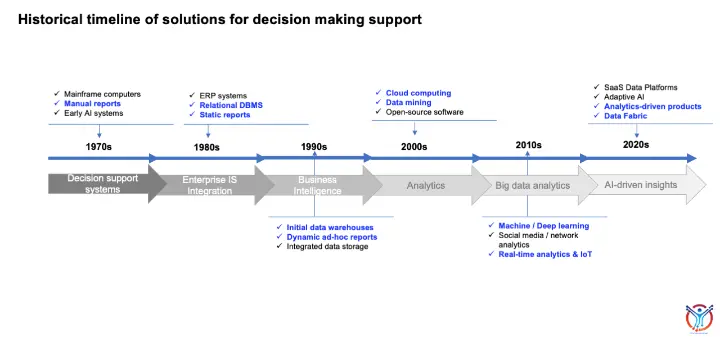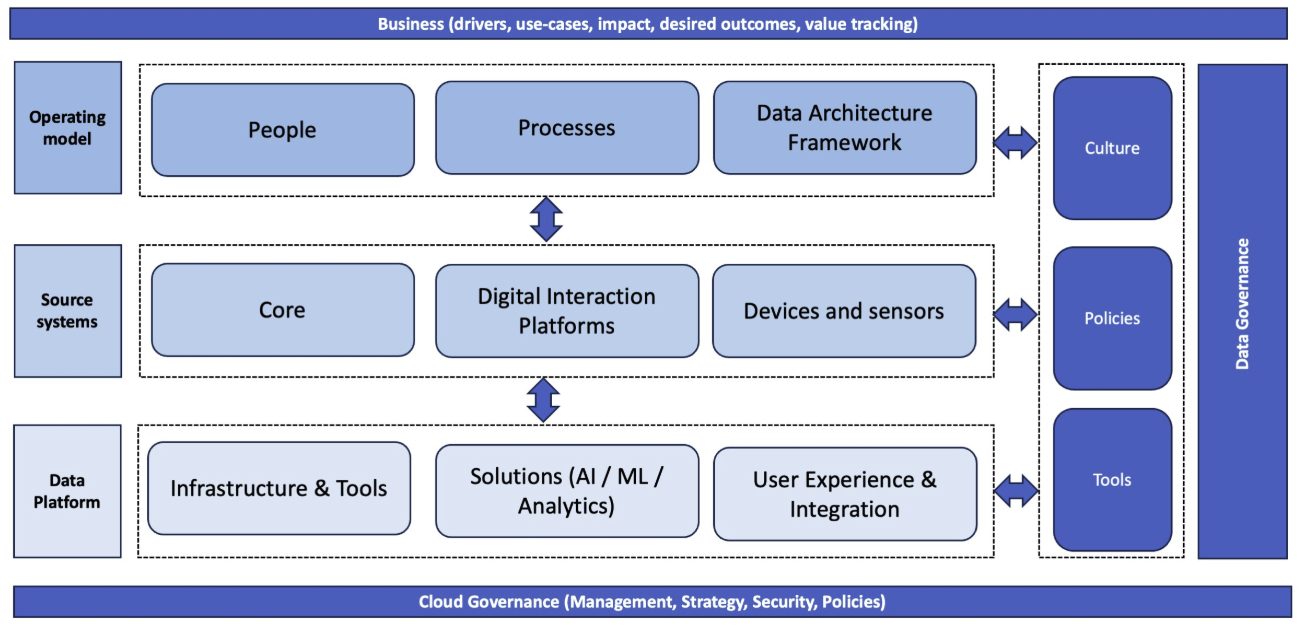Why is the Data Platform Critical for Reporting Automation and AI in 2025?
Imagine data analytics as a detective investigating your business data — and the data platform as their toolkit and workspace. Data analytics processes raw information, organizes it, gives it meaning, and uncovers the hidden story within — what happened, what’s happening now, and what might happen next.
In contrast, the data platform structures that entire process. It ensures proper data governance, provides computational power, and enables organizations to achieve operational excellence.
When it comes to reporting automation, the data platform becomes the essential foundation for scalable, automated reporting solutions. It eliminates the need for manual data handling and guarantees consistency and quality of information across the entire data ecosystem.
To highlight the importance of data analytics and data platforms, let’s look at some of Gartner’s key predictions for the coming years:
- By 2025, Chief Data & Analytics Officers (CDAOs) will widely adopt the data fabric architecture as a core strategy to manage the complexity of data ecosystems. This shift will free them to focus on high-impact business priorities like reporting automation, process digitization, and AI-driven initiatives. The data platform will be their main ally in building an agile, integrated data ecosystem.
- By 2026, over 25% of Fortune 500 CDAOs will be responsible for at least one of their company’s top-revenue-generating products — fully powered by data and analytics. This marks a turning point where data platforms and automated reporting become direct engines of growth and competitive advantage.
- By 2026, 20% of large enterprises will deploy a unified data and analytics governance platform to integrate and automate fragmented governance efforts. This will simplify data architectures and enable more efficient reporting automation across the entire data ecosystem.
In this blog post, we’ll explore how data analytics has evolved over the decades, what has fueled its growth, how AI supports its expansion, and how any organization — regardless of maturity — can start unlocking the value of this rapidly growing field today.
Data platform history in the last years and its role in reporting automation and AI
In this section, we’ll explore the evolution of decision support systems — from early rule-based expert systems and data warehouses, through the era of BI, all the way to today’s world of AI and real-time advanced analytics. Each decade brings unique lessons and shows how the data platform has continuously redefined its role within organizations.

1970s – Expert Systems and Routine Reporting
This decade saw the emergence of the first rule-based expert systems and basic operational reports. The goal was to capture expert knowledge in a structured, machine-readable format to support reporting and decision-making. Automation was static, but it marked the beginning of standardized business intelligence.
1980s – ERP Systems and Relational Databases (RDBMS)
Enterprise-level data integration begins. Systems for automated reporting emerge, duplication of information is reduced, and consistency improves. The data platform becomes the central place for storing and processing business data, opening the door to reliable, scalable insights.
1990s – Data Warehouses and Executive Information Systems
The first data warehouses (DW) and management dashboards are introduced. Reporting becomes visual and strategic, with a growing focus on KPIs and dashboards. The data ecosystem expands and begins serving a broader range of users across the business.
2000s – Business Intelligence and Real-Time Data
BI systems become the backbone of enterprise analytics. Businesses demand access to up-to-date data and the ability to uncover new insights from their data. Subscription-based and service-oriented reporting models emerge. The data platform becomes a catalyst for innovation.
2010s – Big Data, Deep Learning, and Unstructured Data Challenges
The rise of Big Data, along with tools like Hadoop and MapReduce, changes everything. Data from social media, IoT, and mobile devices floods organizations. Data platforms must now support massive scalability, automated integration, and data quality across a fragmented landscape.
2020+ – The Era of AI Agents and Data Democratization
With the growth of OpenAI, DeepSeek, Mistral, and Meta, AI is no longer a luxury — it's a necessity. Expectations for the data platform have never been higher: it must be fast, open, secure, and ready to integrate seamlessly with AI tools and agents. The rise of data literacy brings analytics into the hands of every employee, and the data platform becomes the backbone of everyday work — enabling automation, real-time insights, and strategic agility across the entire data ecosystem.
Key Foundations of a Modern Data Platform
- Data Ecosystem - it is a unified structure for managing data across the entire organization — bringing together people, processes, and technologies. A data platform is a central part of this ecosystem. It should empower various teams to work independently, yet within shared rules, governance, and strategic objectives. Read more about it here.
- Data governance – Modern platforms follow the principle of "just-enough governance" — the right level of control without losing agility. Key components include: data cataloging, classification, data security, regulatory compliance, lifecycle management. Data governance is the core of every modern data platform, ensuring responsible and efficient use of information.
- Data platform architecture - the architecture of a data platform defines how data is managed across the organization and should enable:
- Automation and integration of data combined with reporting automation,
- Security and compliance aligned with industry and internal standards,
- Cross-team collaboration through shared, real-time access to trustworthy data. According to Forrester, implementing a Data Fabric architecture — a key innovation in data platform design — can generate up to 459% ROI.
Data Platform Trends for 2025–2026
Self-Service Analytics
Business users independently explore and analyze data — this requires a decentralized data platform and strong internal data education. Example:
In a mid-sized manufacturing company, department heads (e.g., logistics, maintenance, quality) use Power BI or Tableau connected to a centralized data warehouse built on Microsoft Fabric.
With simple templates and support from a Center of Excellence, they can generate their own reports, analyze trends, and make operational decisions — for example, identifying which machines cause the most errors or which suppliers are regularly delayed.
✅ Benefits: Decentralized data exploration, Faster decision-making and Reduced reliance on IT teams.
AI-driven insights
Data must be ready, consistent, scalable, and accessible for AI to generate real value. Example below:
A B2B services company deploys a predictive AI model that analyzes customer behavior and generates automated recommendations — such as churn risk alerts or targeted cross-sell opportunities. T
he model works on integrated data from CRM systems (like Dynamics 365 or Hubspot), billing platforms, and interaction history, all processed within a central data platform with automated data quality scoring.
✅ Benefits: Improved customer retention, Sales automation and AI-generated reports and actions without developer involvement
Adaptive AI
AI that adjusts in real time to changing business conditions requires a flexible and integrated data platform. Example below:
An e-commerce company based in Gdańsk uses an AI platform to analyze real-time website traffic, product availability, competitor behavior, and conversion rates.
Based on these insights, the system dynamically adjusts prices, product recommendations, and marketing budget allocations — learning continuously from all variables across the data ecosystem. It runs on a hybrid data platform (GCP + on-prem ERP).
✅ Benefits: Increased campaign efficiency and Real-time response to change, without human intervention
How to Start Implementing a Data Platform in Your Company’s Data Ecosystem
4 key steps to achieve the success
Strategy and Business Value
Start by aligning your data-driven strategy with your business reality — including any constraints, such as handling sensitive data or restrictions on public cloud usage.
Assessing Organizational Readiness
Next, evaluate your organization’s maturity and readiness across all critical areas of the data ecosystem.
Operating Model for the Data Ecosystem
To ensure effective operations, define a clear Responsibility Assignment Matrix (RACI). Choose a model that matches your organizational structure and goals:
Implementation
This is where vision becomes reality — select your technology, implement it, and develop business use cases based on priorities.
Step 1 – Key Outcomes
- The first phase should result in a new business model where data analytics and reporting automation are seamlessly integrated into the organization’s daily operations.
- Defined a clear value proposition for each business unit (e.g., operations, finance, HR)
- Prepared an investment cost analysis and established ROI or a cost/benefit analysis
Step 2 – Supporting Questions for Assessment
- Data ecosystem maturity – How ready is your data today, and what does the target state look like?
- Analytics literacy – What are the current use cases vs. future expected use cases?
- AI & data competencies – What skills already exist? What needs to be developed or upskilled?
- Center of Excellence (CoE) – Assess existing policies and build a team of transformation leaders and internal platform champions.
Learn more about roles and competencies in the data ecosystem here,
Step 3 – Example Operating Models
- ecosystem: Centralized model – One team is responsible for developing and maintaining the data platform and collaborates directly with business units.
- Self-service model – The platform is governed centrally, but business units are responsible for building reports and AI models themselves.
- Hybrid model – Data and infrastructure are managed centrally, but business teams develop and automate reporting independently, following shared governance rules.
Read here more about operatin models in Data Ecosystem.
Step 4 – Implementation Details
Choose technology to:
- Align with your chosen data management architecture (e.g., Data Fabric)
- Integrate with existing systems (ERP, CRM, Microsoft 365)
- Ensure ease of reporting automation and data flow
- Be scalable for future AI and advanced analytics
Example technology stacks:
- Microsoft Fabric + Power BI + Power Automate
- Azure Synapse + Azure Data Factory
- GCP Dataform + Looker Studio
- AWS Redshift + AWS Glue + QuickSight
- Low-code platforms: Power Apps, Make.com for custom automation
Example Use Cases
- Automated financial reports in Power BI, integrated with Excel and ERP
- HR dashboards automated via Power Automate and SharePoint
- Real-time operational dashboards from IoT data
- Sales KPI monitoring with AI alerts and recommendations
- Revenue forecasts using machine learning models
Implementation Results
- A working and scalable data platform MVP
- 2–3 fully implemented, automated reporting use cases
- End users trained in dashboards and workflows
- Ready-to-use templates and components for expansion
- A clear backlog and roadmap for scaling the platform
Final Thoughts: The Data Platform as Your Strategic Engine
A data platform is no longer just an IT system. It's the heartbeat of a modern organization — powering all core processes, from operations and finance to AI and innovation.
It serves as the foundation of your data ecosystem, uniting people, technology, and processes under one synchronized framework. It enables faster market response, scalable AI, automated tasks, and real-time decision-making.
And the best part? You don’t need to build everything at once. Start with a Proof of Concept, identify where ROI is the strongest, and grow your platform step by step. Agility, scalability, and ease of deployment are your greatest allies.
Because in today’s world — where data is the new currency — it’s not the biggest companies that win. It’s the ones who know how to use data best.
The Data Platform is the Backbone of Reporting Automation and AI
Want to build your own data platform? Get in touch with us! We’ll guide you on how to get started and what challenges to expect along the way.
